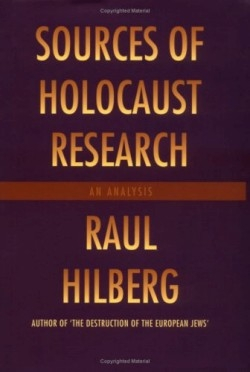
Sources of Holocaust Research
An Analysis
In Holocaust survivor Elie Wiesel’s Night, he writes of
sharing the same concentration camp barracks with his father and watching him as he’s beaten and broken “like a dry tree struck by lightning.” Night is one of thousands of Holocaust sources Hilberg has been studying for more than 50 years. It wasn’t until “a late stage” of his life and career that he turned his analytical lens from the event itself to the question, “What is the nature of my sources?”
Hilberg, Holocaust author, scholar, historian and professor emeritus of political science at the University of Vermont, classifies Holocaust sources—materials he’s “lived with” for years and grown familiar with through his research—by type. He designates three main categories: structures (ruins of the gas chambers at Birkenau), objects (three-dimensional artifacts such as eyeglasses, women’s long hair, victims’ shoes gathered by the SS, a Gypsy cart and a fishing boat that carried Jews to safety from Denmark to Sweden) and two-dimensional items (blueprints, sketches, photographs, periodicals, and verbal testimony).
The author orders his analysis logically, beginning with a chapter on the different kinds of sources, then their composition, style, content, and usability. The chapter on style identifies characteristic means of expression, such as the detached, business-like reports of transportation from ghettos to death camps, itemized by group: “bandits, accomplices, beggars, thieves, vagrants, mentally ill, Gypsies, Jews.”
Hilberg also includes a section on “blunt and blunted” language, the “varnish of legitimacy” that gave rise to phrases like “actions according to the customs of war” to refer to mass shootings of Jews and euphemisms such as “cleansing,” “dejewification,” and “bath houses for special actions” (gas chambers).
For each source designation, Hilberg provides examples, giving readers insight into not only the source material and its potential value and challenges to the researcher, but into the Holocaust itself.
Holocaust researchers seeking a reference guide to available source material and where to locate it may be disappointed. Hilberg’s mention of a few institutions such as the United States Holocaust Memorial Museum in Washington, D.C. and Yad Vashem in Jerusalem is not a comprehensive list, and—as he says in the preface—he doesn’t intend it to be. However, those seeking succinct analysis of a breadth of material with telling examples may find they have a richer context for their own research upon finishing the book.
What Hilberg does intend is to facilitate academics’ ongoing discovery and understanding since, “There is no finality. Findings are always subject to correction and reformulation… the reality of the events is elusive… and the unremitting effort continues… lest all be relinquished and forgotten.”
Reviewed by
Kimberlee Roth
Disclosure: This article is not an endorsement, but a review. The publisher of this book provided free copies of the book to have their book reviewed by a professional reviewer. No fee was paid by the publisher for this review. Foreword Reviews only recommends books that we love. Foreword Magazine, Inc. is disclosing this in accordance with the Federal Trade Commission’s 16 CFR, Part 255.
